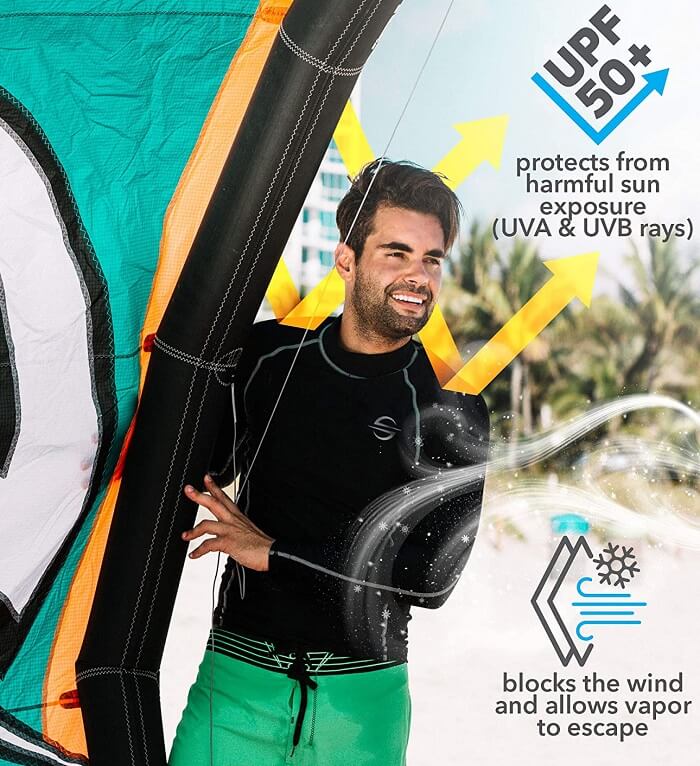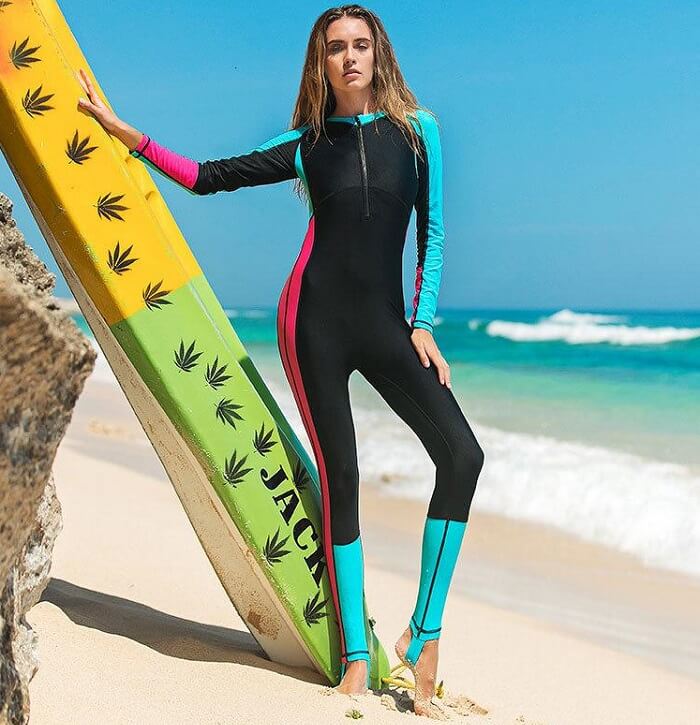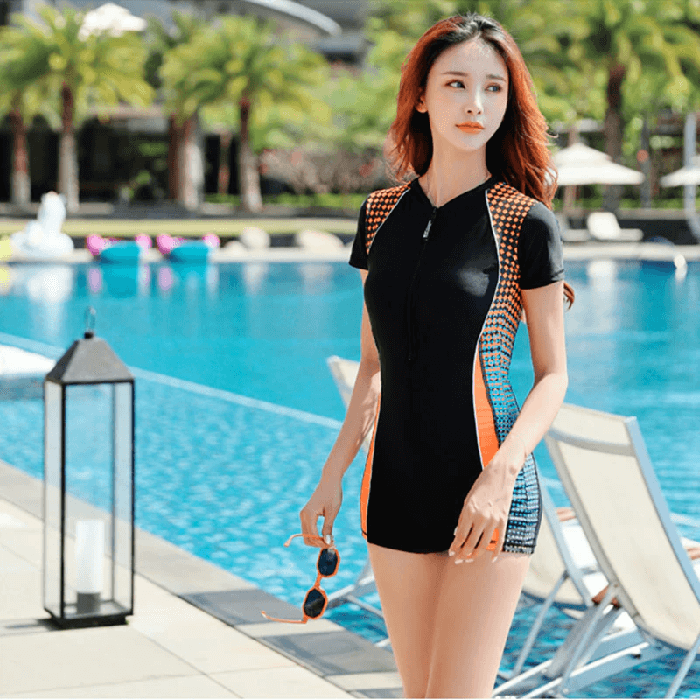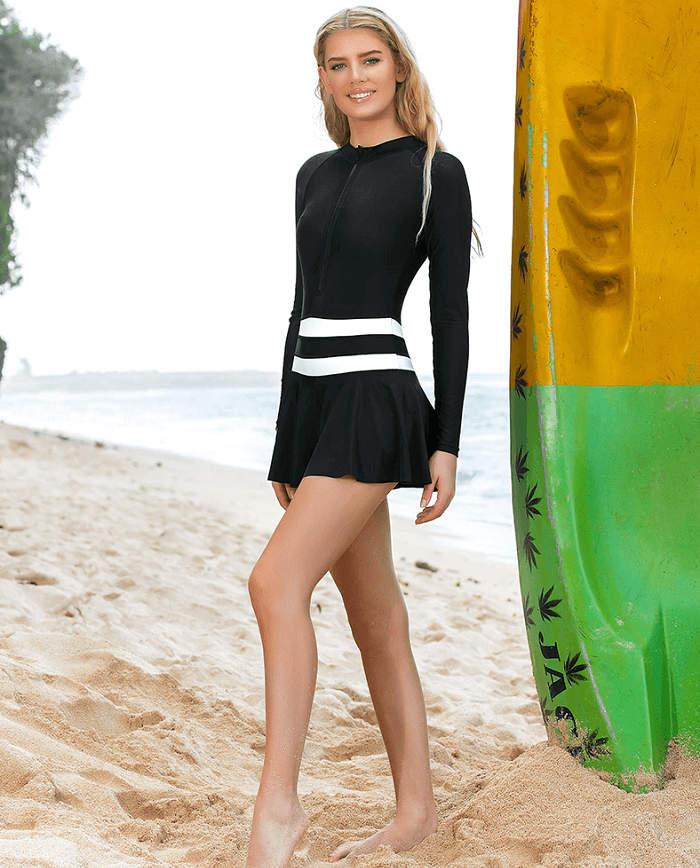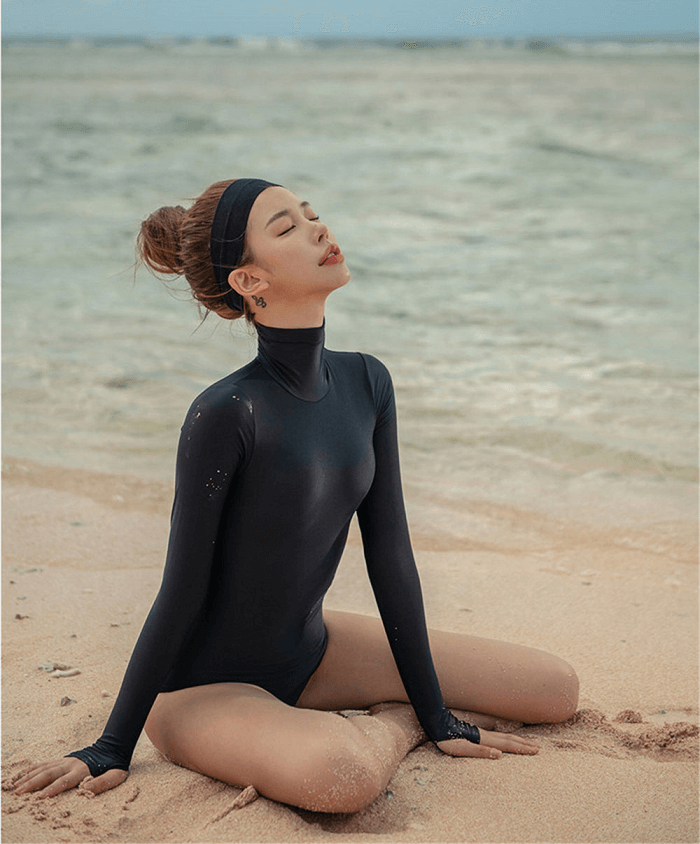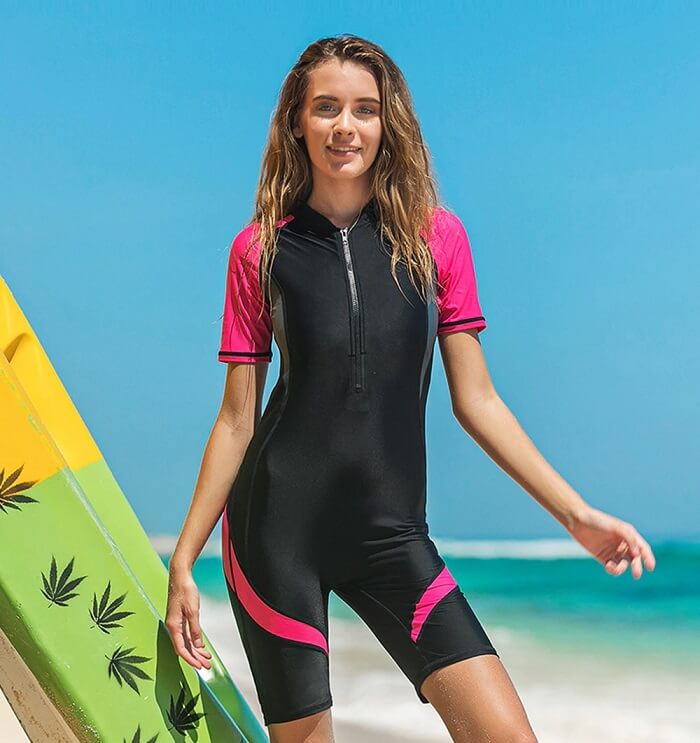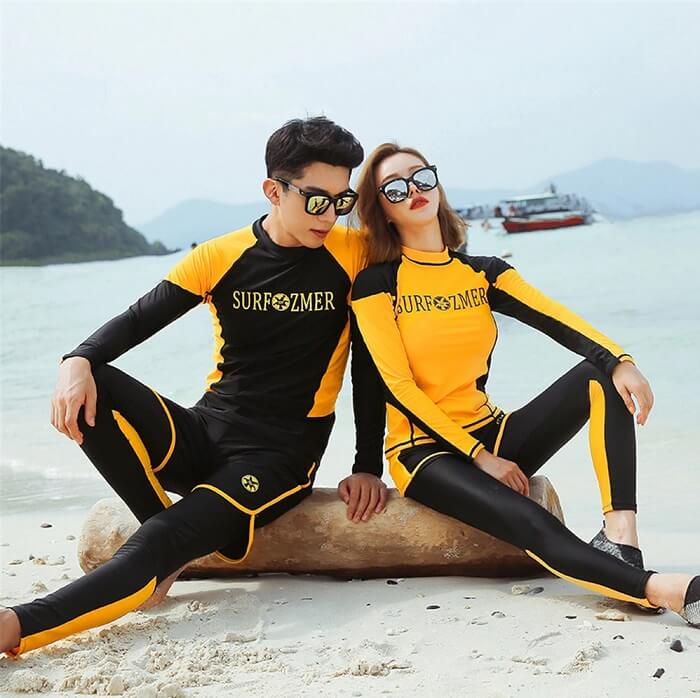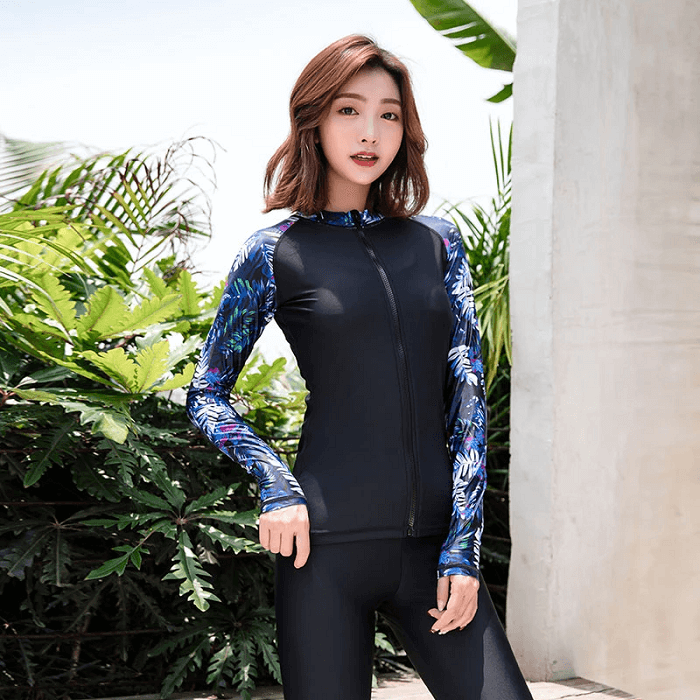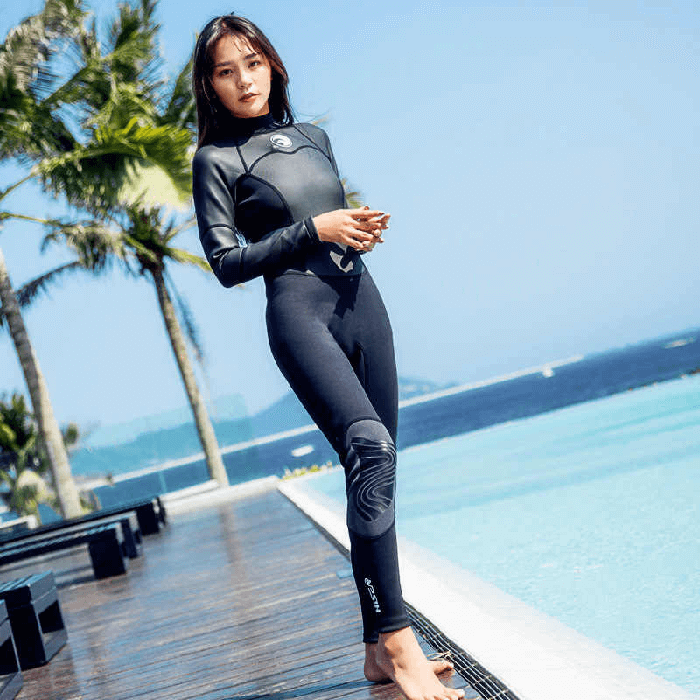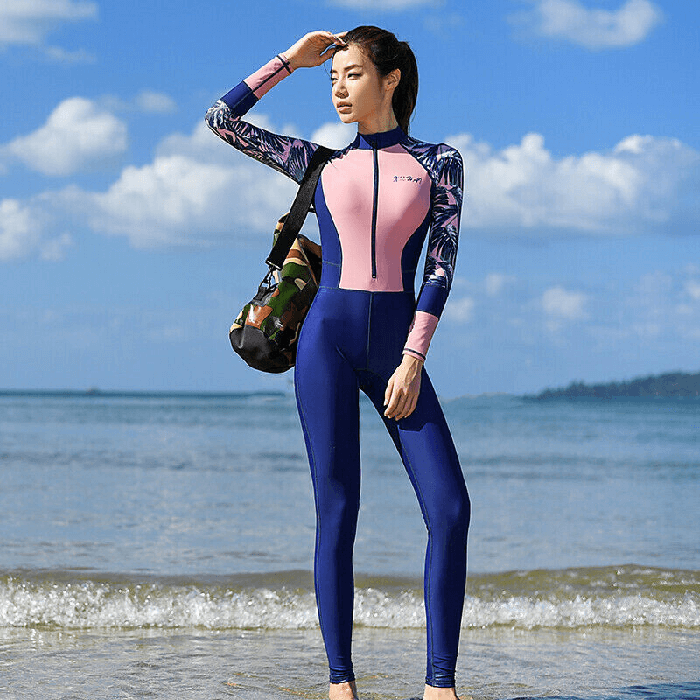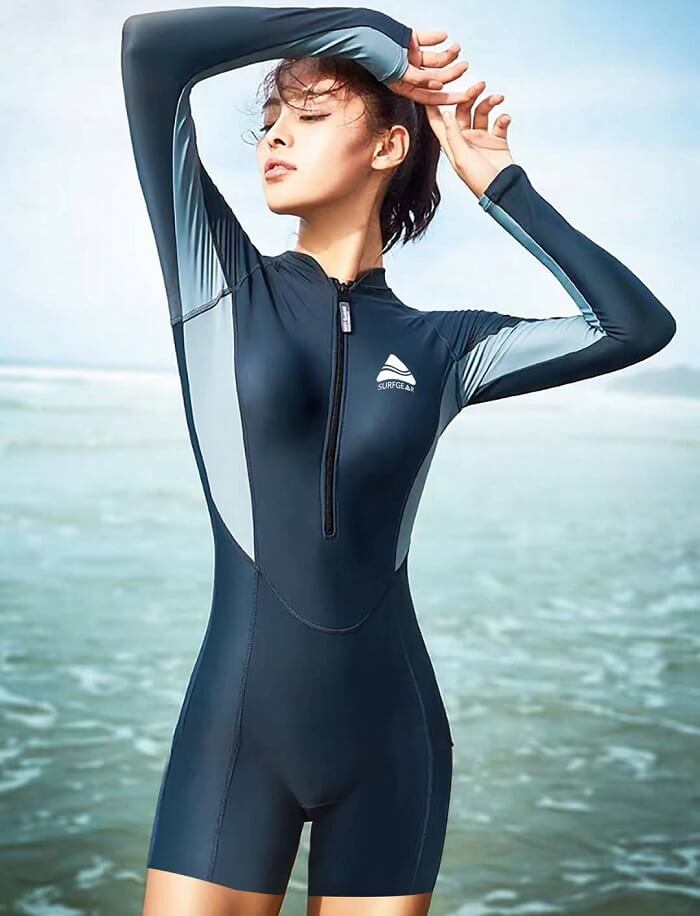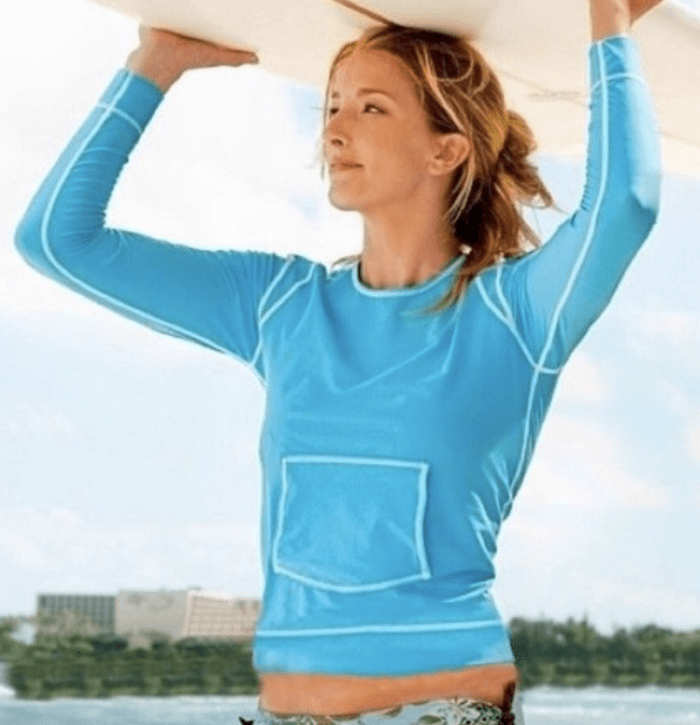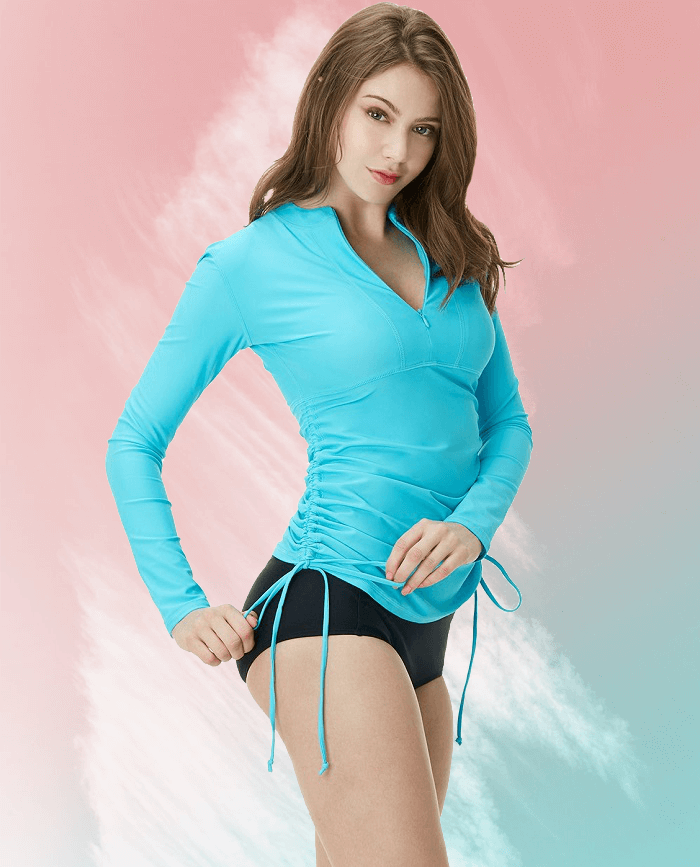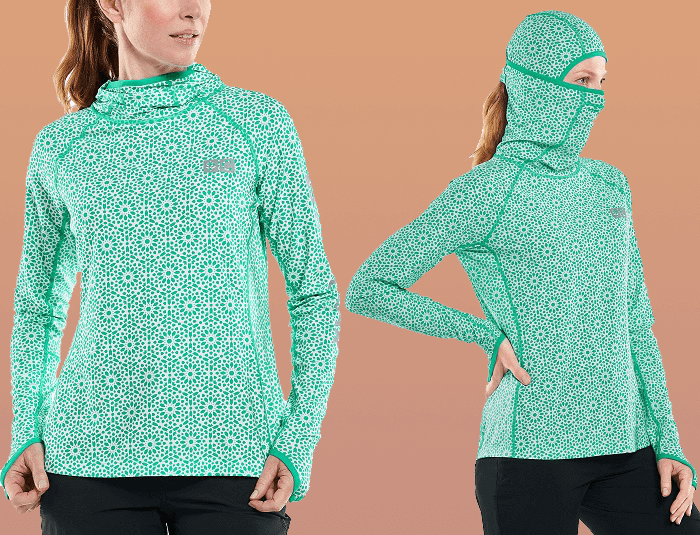Whether you are a novice taking baby steps in the exhilarating world of surfing or a pro-level surfer whose weekend stands incomplete without shredding waves, RVCA rash guard can serve as a pivotal part of your surfing arsenal. The Nike rash guard can keep your skin buffered from the harsh environmental elements so that you don’t have to spend the remaining weeks of your excursion nursing the sunburns.
Hurley rash guards are imperative for sea kayakers and bodyboarder paddle boarders as it delivers the best possible protection. Often the Adidas and Venum rash guards are accompanied with Ultraviolet Protection which acts as a shield against the harmful ultra-violet rays. A UPF rating of 50 or higher is considered best as they filter out 98% UV rays.
Going by its basic nomenclature, Rash Guard Roxy can prevent the horrible breakout of rashes across our front on continuous use of a paddleboard. In the case of kayakers, it can act as a shield of protection while trying to re-board the kayak following a capsize. Seawater has a tendency of reflecting sunlight against our body for making us fall prey to bad burns. But a rash guard with a zipper can stall this process considerably when worn underneath a wetsuit.
Surfers often sport the Hayabusa Rash Guards as a standalone garment for basking in additional warmth when the sea temperature is not on the cooler side. These are mostly made using Nylon, Spandex, Polyester, and neoprene just like most wetsuits. Let us now take a brief look at the different types of Rash Guards and their buying guide for taking the best purchase call.
Types of Rash Guards based on Functionality
1. Thermal Rash Guards
2. Sun Protection Rash Guard
1. Thermal Rash Guards
This thermal rash guard can have your back while taking to chillier water. It operates on the principle that multiple thin layers of material are better at heat retention when compared to one thick layer. People requiring little protection can opt for these Under Armour rash guards. It is advisable to choose the thicker ones for benefitting most out of their insulating attributes.
Summer rash guards have a thickness ranging between 3-5mm whereas winter suits are around 6mm thick. While looking at thickness, you can browse through ratings like 3/2 or 5/6 meant for heavier guards. The thickness of the torso is designated by the first number whereas the later applies to the arms and legs. While deciding on the level of thickness, you need to prepare for the coldest water you might encounter. Also don’t forget to wear a good sunglasses to protect your eyes.
2. Sun Protection Rash Guard
The harmful effect of sunlight gets amplified on the water since the surface tends to reflect back 40% of the UV rays. This is why sea kayakers often complain of an underarm burn which is caused by light burning their armpits and elbows. Over time it can also lead to skin cancer if people are not adequately careful and herein lies the importance of a sun protection rash guard.
Ideally, they should cling to the skin although you can also opt for a size bigger. However, rash guards tend to stretch over time and a super loose suit can get in your way of diminishing productivity. Shorty arm guards are a popular choice of surfers, bodyboarders, and kayakers as they offer comparatively more leeway to your arms. You should make it a point of rubbing on some water repellent sun cream on your lower arms before preparing for an aquatic adventure.
Types of Rash Guards based on Design
3. Rash Guard Vests
4. Full Body Rash Guard
5. Short Pant Swimsuit Rash Guard
6. Ruffle Swimdress Rash Guard
7. High Neck Rash Guard
8. One Piece Swimsuit Rash Guard
3. Rash Guard Vests
These smaller and thinner vests are usually worn while participating in ocean or sea sports. Lululemon rash guard for women and rash guard for men can also be worn alongside premium-grade wetsuit when the mercury takes a dip. These sleeveless vests allow people greater freedom of movement which has led to its popularity amongst sea kayakers, water canoe enthusiasts, and the like. Often the Rash Guard vests contain Lycra for further easing out the movement.
4. Full Body Rash Guard
Stay warm in colder climates with the full-sized rash guard swimsuits which cut off below the midriff and come in as a significant improvement over the regular bathing suit. Surfers adore the full bodyguards as they guarantee additional freedom to their legs whereas kayakers appreciate the fact that their legs don’t succumb to sunburns while sitting on their vessel. The Jiu-Jitsu rash guard is a common proponent of this category.
5. Short Pant Swimsuit Rash Guard
Enjoy those surfing sessions to the fullest with the short pant swimsuit rash guard which offers the perfect blend of style and comfort. They can keep up with your modesty requirements at the regular swimming session and even poolside parties while allowing complete freedom of movement to your legs especially when the weather is slightly on the warmer side.
6. Ruffle Swimdress Rash Guard
Ooze out feminine charm while staying protected from extended exposure to the sun with the ruffle swim dress variants. This style is especially forgiving on ladies who wish to camouflage their tummy flab while the ruffles streamline their appearance.
7. High Neck Rash Guard
A high neckline can be of great help in cold weather scenarios as it prevents water from seeping into the top. This variety of rash guards can also have your back if you suffer from skin sensitivities or if your shoulder often succumbs to extreme tanning after spending some time outside.
8. One Piece Swimsuit Rash Guard
Ladies can nail a sleek look in the one-piece swimsuit rash guards which are accompanied by a built-in bra for bust support and a chest zipper for easy closure. They are usually made up of UV block fabric which can protect you from rashes while you engage in diving, surfing, water yoga, and the likes.
Types of Rash Guard based on Sleeve Length
9. Short-Sleeve Rash Guard
10. Long Sleeve Rash Guard
11. Sleeveless Rash Guard
Rash guards can be availed in short sleeves, long sleeves, and tank options with each coming with its own set of benefits. Tanks are perfect for being worn on hot and sunny days as it offers a greater range of movement to your hands.
9. Short-Sleeve Rash Guard
Beat the heat in style while staying buffered from the sun’s rays with the short-sleeved rash guard which extends up to the elbows. They offer a seamless fit and allow complete freedom of movement. A high stretch construction prevents chaffing from sports equipment and other irritants while swimming.
10. Long Sleeve Rash Guard
Look sharp during your next diving session with the long sleeve rash guards which can keep you feeling warm even when the mercury takes a dip. They are specially engineered to deliver superior performance and offer adequate protection against harmful UV rays.
11. Sleeveless Rash Guard
Types of Rash Guard Based on Materials
12. Lycra Rash Guard
13. Polyester Rash Guard
14. Neoprene Rash Guard
15. Nylon-spandex Rash Guard
Synthetic fiber blends such as neoprene, lycra, polyester, and nylon-spandex blend go into the composition of rash guards. All these materials have varying levels of warmth, stretch, and breathability. Your ultimate decision will be based on the material which can guarantee you the highest level of comfort.
12. Lycra Rash Guard
Lycra is a breathable material offering optimal stretch in the rash guard for diving while preventing chaffing with its quick-drying attributes.
13. Polyester Rash Guard
Polyester rash guards have sweat-wicking attributes and offer maximum breathability to the skin leading to its popularity amongst toddlers with sensitive skin. However, it doesn’t have a similar level of stretch and flexibility as that of a lycra blend.
14. Neoprene Rash Guard
Neoprene guarantees flexibility of movement and adequate insulation which has led to its popularity amongst surfers in cooler waters.
15. Nylon-spandex Rash Guard
Lastly comes a nylon-spandex rash guard which offers a snug fit, adequate stretch, breathability, and quick-drying attributes.
Rash Guards Types Based on Fitting
16. Loose Fit Rash Guard
17. Tight Fit Rash Guard
16. Loose Fit Rash Guard
17. Tight Fit Rash Guard
Rash Guards Types Based on Features
18. Hooded Rash Guard
19. Pockets Rash Guard
20. Bowknot Drape/ Half Zip Rash Guard
21. Paros Sailing Hoodie Rash Guard
22. Ruched Rash Guard
18. Hooded Rash Guard
19. Pockets Rash Guard
20. Bowknot Drape/ Half Zip Rash Guard
21. Paros Sailing Hoodie Rash Guard
22. Ruched Rash Guard
Rash Guard Buying Guide
- UPF – The USP of rash guards lies in the protection it offers from the harmful rays of the sun and the ones reflected by the water. If you are planning on surfing or kayaking, then you need to opt for rash guards with a minimum of UPF 50 for blocking the UV rays.
- Fit – Ideally, the rash guards should ensure a tight fit for bringing down all chances of uncomfortable rubbing or chaffing. But you can also opt for plus size or looser styles that are more forgiving on your extra flab.
- Stitching –Rashguard one-piece swimsuits usually feature a six-panel construction and flat-lock stitching which can offer both rash and chaffing protection.
Rash guards look best when teamed with board shorts for men and the lower half of bikini for ladies. Kayakers can also stay warm by donning on the short or full-sized one-piece variants on longer trips. While the air you are paddling in might be warm, you can be exposed to cold water, and thus it is always advisable to dress accordingly.
Cheryl Carter
Latest posts by Cheryl Carter (see all)
- Custom Leather Patches for Hats: Elevate Your Style by Choosing the Perfect - February 27, 2024
- Types of Curtain Pleats: Explore and Elevate Your Interior Design - February 6, 2024
- Korean Perm Hairstyles Male: Get the K-Pop Look - November 24, 2023

